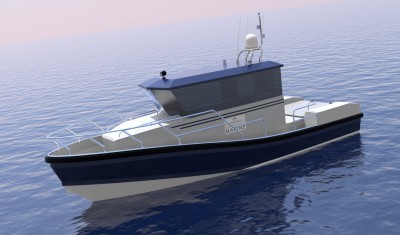By Andy Page, Managing Director and Naval Architect, Chartwell
Despite several commitments to decarbonisation, the International Maritime Organization (IMO) has yet to announce its full backing of net-zero carbon emissions by 2050. However, many are in agreement that these initial mandates are just the tip of the iceberg.
There are clear political drivers towards tackling emissions. Following the launch of the UK’s Clean Air Strategy 2019, shipping minister, UK Nusrat Ghani, re-affirmed the newly elected government’s stance during her keynote speech at a conference organised by the UK Chamber of Shipping and the British Ports Association (BPA) in early January.
During the speech, the Secretary of State for Transport urged the IMO to be ambitious in its approach, while offering greater support from the Department of Transport to facilitate the move. This looks set to be in-line with the Clean Maritime Plan for net-zero emissions in domestic UK waters by 2050. Additionally, a future study has been commissioned to gauge the potential zero-emissions shipping clusters across the UK and identify areas that could act as hubs for low carbon propulsion options.
Opportunities
This drive for research and development across the UK presents some considerable opportunities for ports and harbours, serving as the launch-pad to instigate improved operational practices. The potential to generate significant commercial benefits for UK operators, naval architects and shipyards is also ripe, when considering the infrastructure and technology that will be required to realise these ambitions.
This affirmation of environmental sustainability indicates the start of a move towards joined-up thinking and a sense of shared responsibility. For the sector to tackle these challenges head on, each member of the chain will be required to adapt. From ports to naval architects to shipyards, carbon reduction is a collective responsibility, and this should be reflected in accountability practices.
Increased scrutiny on vessel design is not isolated to the UK. Global legislation has shone the spotlight on vessel design as a key driver to greener operations. In the US, for example, the tightening of environmental regulations has been particularly influential for vessel entry into the market.
Pollution in ports is another catalyst for developing vessel design and alternative methods of propulsion. Port pollution occurs from a range of sources, most typically associated with auto transport and chemical industry activity. However, vessel operations have also been found to be detrimental to the environment.
Ship movement, and idle or loitering boats for example can have a significant impact on local areas. This has been illustrated by an increased ground level of ozone concentration as a result of NOX emissions that have been identified throughout some regions. As NOX emissions correlate to vessel design, there is a strong case for alternative methods of propulsion in order to mitigate the impact.
Greener by design…?
However, this should not be without caveats. When it comes to alternative propulsion solutions for the purposes of emissions reduction, there is a propensity towards suggesting the ultimate in hybrid or zero-carbon systems in order to achieve efficiency gains. However, this mind-set can become reductive for the purposes of achieving the overall aim.
Often, solutions that claim to be zero emissions are reliant on specific operational parameters. If you ignore the living structure of a vessel and its operational profile in favour of installing the latest zero emissions propulsion system, you are at risk of compromising operational efficiency, which can lead to an overall increase in emissions out-put.
Slow-speed vessels with significant pay load capacity, such as tugs, barges, multi-cats or small construction work boats should, where possible, be exploring alternative means of propulsion. This could range from hydrogen, LNG, electric and hybrid variants. Tug boats in particular could make some significant gains from a battery power/diesel solution particularly when taking into account waiting times in ports which can contribute significantly to emissions levels.
Diesel-electric propulsion systems create higher torque, with benefits for push-pull operations. The best part of these solutions is that the technology required to make these updates already exists. More often than not, it is about re-enforcing and improving existing methods of propulsion. For small craft naval architects, there are definitely some creative opportunities to mould these existing solutions.
For faster craft, the alternative propulsion options are less cut and dry. With pilot boats, crew transfer vessels (CTVs) and ferries, for example, the challenge lies in the weight. Simply put, diesel is a lighter fuel source than batteries or hydrogen cells. In these instances, the kwh/kg of stored energy is less efficient than its lighter counterpart. By using these heavier energy sources, you are making the craft itself heavier which can become counter-productive when you take into account the additional resistance factors the vessel now must overcome in order to reach its required speed. As this can only be accomplished by using more fuel, it’s easy to see how this can quickly result in an operational deficit, putting a strain on bank balances and the environment.
Efficient operations

It’s not only weight that needs to be considered. Operational profiles can also have a bearing on the efficiency of the propulsion solution. Vessels operating in areas such as the Thames, Norwegian Fjords, and Scotland – in lochs, inshore and coastal waters, hybrid solutions can be effective in some scenarios. Moving further offshore, the change in sea and weather conditions mean that novel hybrid-combinations may once again prove counter-intuitive for realising operational efficiencies.
In these instances, researching improvements on existing vessels to counteract the additional resistance can be equally effective when it comes to improving efficiency and reducing carbon emissions. For example, there’s no reason why on high speed pilot operations you couldn’t look to installing a changeable pitch propeller solution and a vessel stabilisation system. Changing the pitch to suit the conditions will reduce the amount of fuel burnt for the same given operation.
In larger shipping there are some very well-established sail technology applications that, pending further investigation, could be employed by smaller vessels for a low-risk solution.
What this all amounts to is a holistic approach to design, build and operation, while not losing sight of the overall aim – to reduce emissions. Hybrid solutions are often pitched in isolation as a cleaner way to operate, but it is all too easy to forget the reality of day-to-day operations.
There have been many instances of fitting electric drivetrains when, on reflection, better planning and route optimisation would have significant reductions on fuel usage. Naval architects must seek the most efficient form or combination of propulsion systems depending on the operational requirements of a project. The emphasis should be placed on a strategic approach that takes decarbonisation projects on a case-by-case basis.



